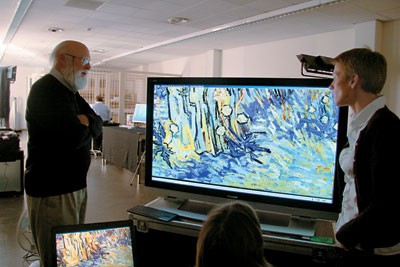Engineering's Rick Johnson helps museum apply a gallery of technology to authenticate art masterpieces
By Robert Emro
Growing up in small-town Georgia, C. Richard Johnson Jr. never visited an art museum, heard a classical music concert or attended serious theater. A second-grader when the Soviets launched Sputnik I and the ensuing space race, Johnson was channeled into engineering when he exhibited an early aptitude for math and science. Not until he was a student at Georgia Tech did he get his first taste of fine art.
He was in Germany with a study abroad program. His travels took him to the Gemäldegalerie (picture gallery) in Berlin. When Johnson visited in the early 1970s, it held an impressive collection, including "The Man With the Golden Helmet," one of Rembrandt's most famous paintings. Seeing it for the first time was a revelation. "I spent several hours in the Rembrandt rooms," says Johnson. "I didn't know why. I just had some kind of response to it."
As an electrical engineering grad student at Stanford University, Johnson took a course on Rembrandt knowing that if he bombed, the F would not appear in his record. Far from flunking, he was one of the star pupils. During one test, he was the only person to realize that a slide of a Frans Hals painting had been loaded backward. He could tell because Hals always painted the light falling from the left.
Johnson graduated in 1977 with Stanford's first Ph.D. minor in art history. The topic of his final project, appropriately enough, was Vermeer's use of the camera obscura. Careful measurement of the angles in his paintings and reconstructions of the rooms in which he painted them have led some to argue that Vermeer used this rudimentary optical device in creating his almost photographic paintings.
"It was a survival technique to get myself through engineering, to some extent," says Johnson. "Art history is something I found a passion for that I see in my students for technical things that I sometimes don't have."
Johnson joined the Cornell faculty as an associate professor in 1981. He continued a successful academic engineering career in the School of Electrical and Computer Engineering, first working on the theory behind adaptive feedback systems, used to kill the echo you can sometimes hear while talking on the telephone. Then he created and analyzed blind equalization algorithms, used in receiving hi-def TV. In 2005, when he was ready to change his research focus once again, he began wondering how his expertise in signal processing could get him a backstage museum pass.
Art historians and curators use a variety of technologies to study paintings, including X-radiography, infrared photography and UV fluorescence. While on a Fulbright in Paris, Johnson arranged a lunch meeting with a curator at the Van Gogh Museum in Amsterdam. He offered his services as a translator helping the art history experts at the museum communicate with technical types doing image processing.
While preparing a presentation to museum management, Johnson discovered that these tools helped de-attribute the very painting that awakened his passion for art in the first place. In 1985, the Rembrandt Research Project determined "The Man with the Golden Helmet" was not painted by Rembrandt but by an unnamed apprentice.
The museum liked the idea of having an expert in signal processing to help connect them with computer-based technology used in painting authentication and gave Johnson a five-year appointment as an adjunct research fellow. "I'm like a Ph.D. student again, working for the head of conservation at the Van Gogh Museum," he says. "Whether the data comes from a CAT scan or a satellite or a painting, it becomes an array of numbers to which the kit of signal processing tools can be applied."
Beyond determining if a painting is really by a master or just a clever forgery, forensic signal processing can help art historians determine the sequence of an artist's work or deconstruct a painter's process by identifying which strokes went on first. "There are a lot of things I think [curators] can think of that would be impossible, but there are a lot of things we should be able to do," says Johnson. "Any time the art historians look at the image for the information they need, we should be able to help."
In a year or so, Johnson envisions teaching a new course at Cornell examining how others have approached using signal processing to authenticate art so students can infer a general approach to the problem. He hopes his interaction with the museum will eventually result in a textbook that combines art history with technical material. "I'm not an engineering professor just because I want to tinker with cool things," he says. "I'm an academic because I want to teach cool things."
Robert Emro is a communications specialist in the College of Engineering. The story was originally published in the spring 2008 issue of Cornell Engineering Magazine.
Media Contact
Get Cornell news delivered right to your inbox.
Subscribe